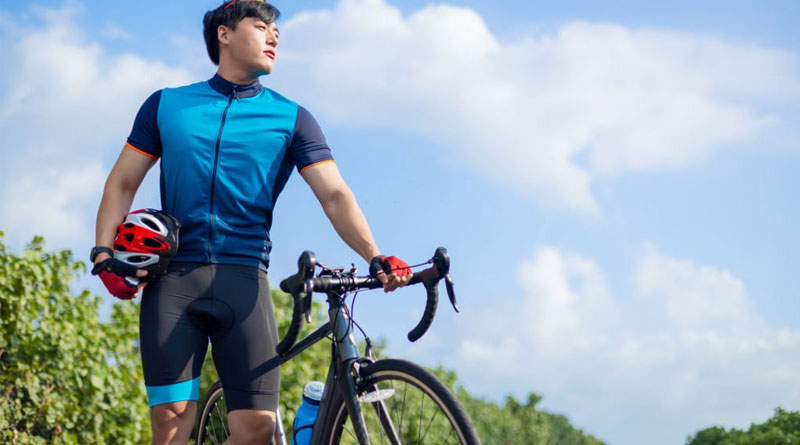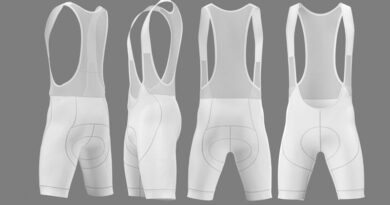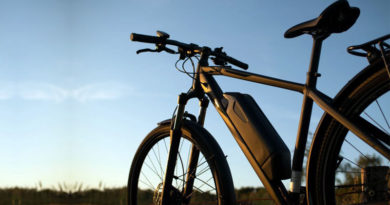What is Chamois in Cycling?
If you are a beginner bike rider, you would have come across the term chamois. You would have heard how important it is and how choosing the right one matters. It sounds like something very important in the cycling world. Perhaps, that’s why you are here. So what exactly is a chamois? A chamois is padding sewn into the bike shorts and covers the crotch to provide cushioning. Getting the right one would make your rides very comfortable and enjoyable. Chamois come in all shapes and sizes to cater to different body types and are gender specific. Male and female chamois are anatomically different to provide the protection both genders need.
A brief history of Chamois
Padding in cycling shorts was introduced in the 1940s in Europe. At first, it was made of sheep leather. But later, it was upgraded to chamois leather. Chamois (Scientific name: Rupicapra rupicapra) is a species of goat-antelope native to the mountains of Europe. They were later introduced in New Zealand and can also be found there. The leather from chamois is very soft and it replaced the sheep leather, hence, the name chamois. But today, chamois are not made of leather. Instead, it is a pad made of gel or foam or both but the name Chamois has stuck. There is also a debate about dropping the name Chamois altogether since pads are not made of Chamois anymore.
Do you need bike shorts with a chamois?
You don’t need a chamois in your shorts if you only ride around the neighborhood for short distances. But you should get a pair of padded shorts if you intend to ride for long distances. Once you use them, you would understand the wisdom behind them.
The purpose of having a chamois in bike shorts is to provide the ischial bones (the sit bones) with cushioning and support. It is essential because the saddle has a small surface area and sitting on it for long periods means the whole body weight is on the crotch. As a result, the pelvic pudendal nerve suffers vascular or nervous damage or both. The condition is known as bicycle seat neuropathy and it causes extreme pain in the crotch and numbness in the legs.
Chamois fit, shape, and thickness
When it comes to the fit of the chamois, there is no ‘one size fits all’ approach. Bike shorts that work great for some do not work well for others. It requires some trial and error to find the chamois that fits perfectly. The main difference is the thickness of the chamois. Chamois can vary between thin and unobstructive to thick and bulky.
A thicker chamois is usually firm and doesn’t compress easily. The thickness depends on how long the riding period will be and how much support you want. A thin chamois is fast drying and is usually used by triathlon athletes.
Now, you may think a thicker chamois is better because it provides more cushioning. But that is not always the case. Thicker chamois are bulky and compromise saddle feel. They also weigh more. Thicker chamois are usually used by beginner riders who need more support on the saddle. As the riders become more adept at cycling, they opt for thinner chamois. The key is to find a balance between saddle feel and the support you need.
Chamois is made of two types of materials; gel or foam, and sometimes, both. A gel chamois is thinner, firmer, and more dampening. Foam, on the other hand, is bulkier and compresses faster than gel. Needless to say that a gel chamois is superior to foam and. obviously, more expensive. But If you are a competitive rider, then you should invest in a quality chamois.
Your riding style is another factor that influences the shape of the chamois. How you sit on your saddle determines where the pressure points are going to be requiring more support in those areas. For example, on a road bike, the forward leaning position means that there would be more pressure at the front of the crotch. If you notice, chamois for road cycling provide more coverage and cushioning at the front. Chamois for hybrid bikes have more cushioning in the middle as sitting upright means there would be more pressure at the middle of the crotch.
Gender is another factor that influences the shape of the chamois. Chamois are gender specific due to the physiological differences between men and women. Women have wider angled sit bones so women’s chamois provide more coverage and continuous cushioning at the back. Chamois for men have a central groove to allow better blood flow in the crotch area to prevent numbness.
One important thing to keep in mind is that many bike shorts from different brands would feel the same. Don’t be surprised by that. The reason for such striking similarity is that many brands source their materials from external companies. Sourcing chamois from the same external companies provides a similar feeling in performance.
Features to Look for in a Chamois
The following are some of the few features that you should look for in a chamois when buying a pair of padded bike shorts.
Padding technology
Chamois features either 2D or 3D padding. 2D padding is cheap because it uses less material and it is also flatter, hence, “2D”. 3D padding has more depth to it because of the grooves. Running fingers through the chamois would provide you with a sense of layers and padding. A more expensive option is memory foam which conforms to the body shape after some time of use and improves comfort.
Serious riders with little financial limitations should go for the 3D ergonomic chamois. These chamois are custom-designed around the body. The advantage of such chamois is that they are comfortable from day one. They don’t require any break-in period or time to adjust. But of course, they cost a lot. However, the comfort is far better than any off-the-shelf chamois.
Vibration and shock absorption
One of the most important functions of a chamois is shock and vibration absorption. Imperfections and bumps in roads travel to the body via contact points on the bike. These high-frequency waves and shock from the rolling tires cause fatigue and pain in the body. As mentioned earlier, gel chamois are better at absorbing vibrations and shocks. The more shock absorbing the chamois is, the longer the comfort on the ride.
Breathability
Breathability is another important factor to look for in a chamois. Sweat build-up in the crotch area causes the fabric to stretch and crunch up under the skin which causes chafing. Sweat build-up itself causes irritation chaffing, and rash on the skin.
A breathable chamois doesn’t allow sweat to build up and keeps the crotch area cool. High-end chamois are perforated to increase breathability and reduce weight. But all chamois have some breathability features regardless of the budget. Moisture-wicking is another feature that contributes to the breathability of the chamois.
Anti-bacterial properties
Sweat build-up is inevitable under high-intensity activities, especially during summer and hot days. No matter how breathable your chamois is, you would have to deal with sweat. Of course, sweat means bacteria. If your chamois becomes a healthy breeding ground for bacteria, it can easily lead to saddle sores and other nasty rashes. Chamois manufacturers often add an anti-bacterial layer to prevent bacterial activity and also the smell that results as a consequence.
Common chamois mistakes
Some of the common mistakes that beginner and intermediate riders often make, ruin the performance of the chamois. Here are the mistakes you should avoid.
Wearing underwear with padded bike shorts
There is no need to wear underwear with padded bike shorts. A chamois is made to work on its own. Wearing underwear causes the same problems that you are trying to avoid in the first place. The underwear fabric rubs against the skin causing chaffing and abrasion, something that the chamois was supposed to avoid.
The underwear also prevents the anti-bacterial layer of the chamois from working making the underwear a bacterial breeding ground leading to saddle sores. But there is one exception where you are allowed to wear underwear with a chamois. That is when you are trying out bike shorts to buy. Different people trying out a pair of bike shorts increases the chances of contracting a bacterial or fungal infection.
Not washing the shorts properly
Most people are afraid to wash their padded bike shorts believing that it would ruin their expensive shorts. But washing bike shorts is necessary. You should avoid reusing your bike shorts without washing them. The sweat and oil from the body accelerate the deterioration of the chamois shortening its lifespan. The chamois also develops a foul smell, as if a rat died and left to rot in the shorts.
Washing the shorts in the wrong way damages the chamois and also shortens its lifespan. Bike shorts are made to be washed normally like your daily clothes. They don’t need any special treatments or detergents. Just rinse them before putting them in the washing machine to get rid of any dirt particles. Don’t use hot water to wash the shorts and don’t use a dryer to dry them after the wash. Don’t use softeners after washing the shorts. All these activities damage the chamois and the fabric of shorts irreversibly.
Abusing the chamois cream
Chamois cream is supposed to be used in small amounts for it and the chamois to function properly. Unfortunately, some people use too much chamois cream. What that does is it makes the surface too slippery and you would slide around on the chamois. The sliding causes friction leading to chaffing and also prevents the chamois from performing its function. Plus, a sliding chamois between the legs is just annoying. Abusing the cream also makes it run out faster.
Using petroleum-based anti-chaffing cream
A worse crime than abusing the chamois cream that many people commit is the use of petroleum-based creams. You would also find many people advocate such transgression with pride. The whole weight of their argument resides in the fact that petroleum-based creams are cheaper and are also lubricants like the chamois cream. DO NOT listen to them.
Petroleum-based creams and petroleum jelly are cheap, no doubt, but they destroy the chamois. Petroleum jelly and petroleum-based creams get absorbed in the chamois, especially, a gel chamois. Once absorbed, they are not easy to wash off. They also ruin the anti-bacterial layer of the chamois and they also cover perforations or pores compromising the breathability of the chamois.
If you look at it in the long term, buying chamois cream is a lot cheaper than buying a new pair of bike shorts just because your cheaper cream destroyed the chamois. If you are still in doubt, chamois and saddle manufacturers, both void warranty in case of petroleum jelly damage. So avoid the cheaper petroleum-based creams and stick to a dedicated chamois cream.
Final Thoughts
A chamois is padding in bike shorts that provides protection to the groin and makes the ride more comfortable. The word chamois refers to a species of goat-antelope in the European mountains and New Zealand from which this padding was made. Today, it is made of gel or foam, or both. Gels ones are better and more expensive because they don’t compress easily.
The shape of chamois is gender-specific to cater to the different physiological needs of men and women. The shape also depends on the riding style as different riding styles mean different pressure points on the saddle. The thickness of the chamois depends on how long you are going to ride and how much support you need.
When buying padded bike shorts, make sure to look for features like pad technology, shock absorption, breathability, and anti-bacterial properties. Avoid common chamois mistakes like wearing underwear with your shorts, not washing them properly, abusing the chamois cream, or using petroleum-based cheap creams.




